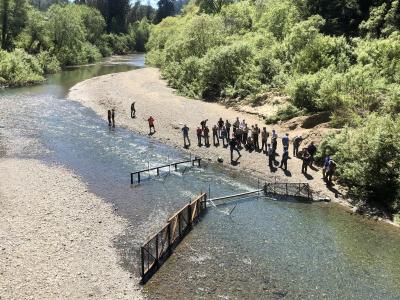Holding Space—Restoring Habitat and Making Room for Innovation
March 26 - 29, 2024
Beaver and Process-Based Restoration: Opportunities and Obstacles
29 March 2024
9:00am - 5:00pm
Session Coordinator: Karen Pope, PhD, USDA Forest Service
Climate change represents a major threat to freshwater aquatic ecosystems in California and the Pacific Northwest, home to important but increasingly sensitive taxa including salmonids. The impacts of climate change on certain freshwater ecosystems may be ameliorated by the engineering activities of beavers (Castor canadensis), which were once common throughout North America but experienced dramatic declines due to fur harvest in the 18th and 19th centuries. Many streams and rivers have not been recolonized by beaver due to a lack of local source populations or because the habitats have been simplified and degraded, impairing beaver recolonization. Strategic stream, meadow, and river restoration applications with beaver and process-based restoration (PBR) have the potential to play a larger role in the multi-tiered efforts to manage pressing climate-related threats to forests and water supply by increasing resistance to wildfire, increasing base flows, and reducing sedimentation in unwanted reaches and reservoirs. In these systems, beaver restoration and PBR have the potential to recover stream complexity, increase surface and groundwater storage, and regain floodplain connectivity, resulting in improved salmonid habitat. However, we are just beginning to develop the restoration tools, scientific backing, and workforce to meet the demand for increasing the pace and scale. For example, we launched the new California Process-Based Restoration Network in 2022 with a goal of increasing capacity to restore degraded riverscapes in California (calpbr.org). In addition to building the human capacity to implement restoration projects, research and monitoring remain important for understanding and identifying where and when beaver restoration and PBR can succeed and what approaches are best to maximize ecohydrological benefits. The primary goals of this session were to (1) share what has been done, how it is working, and the scientific basis that supports it; and (2) to explore the various impediments to scaling up the more effective practices.
Beaver and Process-Based Restoration: Opportunities and Obstacles 1
Bringing Back Beaver to California: How We Got Here and Where We Are Going Next, Kate Lundquist, Occidental Arts & Ecology Center
The Process Paradox: Overcoming Challenges for Process-Based Restoration in the Regulated Rivers of California's Central Valley, Rocko Brown, PhD, PE - Cramer Fish Sciences
Evaluating and Forecasting Restoration Benefits for Trout and Salmon with Spatially Explicit Modeling, Bret Harvey PhD, USDA Forest Service Pacific Southwest Research Station
Short-Term Hydrologic Responses to Process-Based Restoration, Emma Sevier, MS, California Polytechnic State University Humboldt, Pacific Watershed Associates
Scale Dependence and Habitat Selection by American beaver (Castor canadensis), Caroline Gengo, UC Davis Center for Watershed Sciences
Process-Based Restoration in the Upper Klamath Basin: Stories, Lessons Learned, and Continued Challenges, Charlie Erdman, Trout Unlimited
The Bright Green Future for Process-Based Restoration, Michael M. Pollock, PhD., National Oceanic and Atmospheric Administration
Beaver and Process-Based Restoration: Opportunities and Obstacles 2
Expanding Process Based Restoration in California with a Network Approach, Carrie Monohan, PhD, The Sierra Fund
Process-Based Restoration Enhances Geo-Hydro-Bio-Diversity in Riparian Systems Post Dam Removal: A Case Study of Dry Creek in the Northern Sierra Nevada Foothills, Matt Berry, Sierra Streams Institute
Symbiotic Restoration on Martis Creek, Truckee California – A Story of Inter-Species Cooperation, Catherine Schnurrenberger and Peter Kulchawik, C.S. Ecological Surveys and Assessments and Balance Hydrologics
Well? Did it work?, Kevin Swift, Swift Water Design
Process-Based Restoration in Burned Headwater Meadows: Exploring Potential for Sediment Storage and Floodplain Reconnection, Kate Wilcox, Oak Ridge Institute for Science and Education Fellow, USDA Forest Service, Pacific Southwest Research Station
Do Beaver Dam Analogs Facilitate More Optimal Foraging by Juvenile Coho?, Brandi Goss, UC Davis
10 Years of Experience Working with Beaver for Restoration in a Human Dominated Landscape, Betsy Stapleton, Scott River Watershed Council

